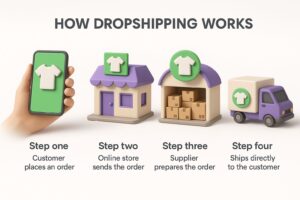Quick Links
ToggleThinking about starting your own business, but don’t want to deal with inventory or storage? Dropshipping might be just what you’re looking for. It’s a low-risk way to enter the world of eCommerce where you sell products online without actually keeping them in stock. In this guide, we’ll walk you through how to start a dropshipping business in India. Whether you’re a student, a working professional, or someone just exploring new income streams, this is something you can get into with minimal investment. Let’s take a closer look at how it works.
What is a Dropshipping Business in India?
Dropshipping is a way to run an online business in India without keeping any stock. You list products on your website, and when someone places an order, you send the details to a supplier. That supplier takes care of packing and shipping the product directly to your customer. You don’t need to handle the product yourself. Your profit comes from the difference between what the customer pays you and what you pay the supplier. You’re basically the link between the buyer and the supplier, managing the store and setting the price.
Why Start a Dropshipping Business in India?
Here’s why starting a dropshipping business in India is a great idea:
-
Low Investment
Starting a dropshipping business doesn’t need a big budget. Since you don’t have to buy products in advance or rent a warehouse, your initial costs stay low. All you need is a basic online store and a reliable supplier to get started.
-
Ability to Scale Without Holding Inventory
You can grow your business without worrying about storage space or stock levels. As your orders increase, your supplier handles the extra load. This makes it easier to scale up your business without spending on inventory or expanding physical space.
-
Exploring and Being a Part of India’s Growing E-commerce Market
Online shopping is growing fast in India. More people are buying products online than ever before. Dropshipping gives you a chance to enter this space quickly and test different products to see what works. It’s a smart way to tap into a booming market without heavy risks.

How to Start a Dropshipping Business in India?
Starting a dropshipping business can be an exciting journey, especially with the growing number of Indian consumers shopping online. If you’re thinking about giving it a shot, here are the key steps to starting a dropshipping business in India.
Step 1: Selecting a Profitable Niche
Your first step is choosing the right niche. This decision can make or break your business. Think about what people in India are actively buying right now. Electronics, fashion items, home decor, kitchen gadgets, beauty products, and pet supplies are just a few examples of hot-selling categories. You can also look into eco-friendly products, spiritual accessories, or region-specific items that are not easily available everywhere.
The goal is to pick something that not only has demand but also gives you a chance to stand out. Don’t just go for what everyone else is selling. Look for a gap in the market. If you can offer a product that’s unique or hard to find, you’ll have a much better chance of building a loyal customer base.
Step 2: Choosing the Right Platform
Your next big step is picking the right platform to build your store. And this is where Zopping makes things incredibly simple.
Zopping is built for Indian sellers. It’s affordable, easy to use, and comes with mobile app integration so you can manage your business on the go. You don’t need coding knowledge, and since it’s designed for the Indian market, payments, logistics, and support all feel more tailored to your needs.
Other platforms to consider include:
- Shopify: Great for beginners who want a clean and simple store setup.
- Amazon: Lets you tap into a ready-made marketplace, though you’ll have to compete with many other sellers.
- WooCommerce: Works well if you already use WordPress and want more control and flexibility.
Still, if you’re looking for something that’s truly Indian, easy to start, and cost-friendly, Zopping should be your top choice.
E-commerce Growth Unlocked
Book a DemoStep 3: Registering Your Business
Now it’s time to take care of the legal side of things. Registering your business gives you more credibility and also keeps you compliant with Indian laws.
You can either register as a sole proprietor if you’re starting small or form an LLP (Limited Liability Partnership) for better structure and protection. Also, don’t forget to get your GST registration done. This is important if you plan to sell across different states or if your revenue crosses the GST threshold.
Make sure you stay updated with taxation rules and keep proper records of your income and expenses. Legal compliance might seem boring, but it will save you a lot of trouble in the long run.
Legal and Tax Considerations
Before you go all in, make sure your business is legally set up.
- GST Registration and ComplianceTo operate a dropshipping store in India, you need to register under GST. This allows you to sell legally and claim input tax credits. Make sure you keep track of your invoices and file returns on time.
- Business LicensesDepending on your location, you may also need a basic shop establishment license or other local permissions. It’s a good idea to check with a local consultant to avoid running into compliance issues later.
Step 4: Finding Reliable Suppliers
Your business depends heavily on the people who supply your products. So finding the right suppliers is one of the most important parts of the dropshipping journey.
You have two options here: domestic suppliers or international suppliers. Local suppliers are a big advantage in India because they offer faster delivery and local customer support. That means fewer complaints and better reviews. If you want to explore international options, platforms like AliExpress, Oberlo, and Spocket are good places to start.
Before you commit to a supplier, check their reviews, product quality, and shipping timelines. Order samples if you can. You don’t want your customers receiving poor-quality products or waiting for weeks.
Step 5: Set Up Your Online Store
Most people think starting an online store means hiring developers or spending weeks building everything from scratch. That might be true for some, but it doesn’t have to be your story.
With Zopping’s no-code store builder, you can launch your online store quickly without any technical skills. The platform comes with ready-to-use templates designed specifically for Indian businesses. Setting up product categories, adding delivery options, and managing inventory are all done through simple drag-and-drop tools.
Here’s how to create your store on Zopping:
- Pick a theme that suits your business. Some designs feel familiar and relatable to the Indian audience, which helps in building trust.
- Customize your store with your brand name, colours, and images to make it feel like your own.
- Add your products, write clear and convincing descriptions, and set your prices in a way that matches your target customers.
- Set up payments using Razorpay, Paytm, UPI, and other popular options. These local payment gateways make the checkout process smooth and convenient for your customers.
Once your store looks good and functions well, you’re ready to go live and start accepting orders.
Effortlessly Customize a Secure, Code-Free Store for Businesses Across All Industries
Book a DemoStep 6: Order Fulfilment and Customer Service
Getting orders is great. Fulfilling them on time and keeping customers happy is even more important.
Order Fulfilment Strategies
Automate order tracking and shipping updates using tools that work well in India. Partner with delivery services like Delhivery, India Post, or Shadowfax for smooth last-mile delivery. Quick, reliable delivery builds customer confidence.
Handling Returns and Refunds
Set a clear return and refund policy. Mention what can be returned, within how many days, and in what condition. Be transparent. Also, respond to complaints quickly and politely. Great customer service goes a long way in keeping people coming back.
Step 7: Marketing Strategies
Building a great store is just one part. Now you need people to find it.
Social Media Marketing
Start with platforms where Indian consumers spend the most time. Instagram, Facebook, and YouTube are some great options. Share product updates, reels, tips, and festival offers to get noticed. Partner with local influencers who understand your target market. Even a few shoutouts can drive real traffic if done right.
SEO and Content Marketing
Think about what people in India type into Google when looking for products online. Use those search terms on your website. Write simple blog posts or create short videos that answer common questions or give helpful tips. This brings in organic traffic over time and helps you rank better on search engines.
Paid Advertising
Platforms like Google Ads and Meta Ads (Facebook + Instagram) let you reach specific customer groups. You can target by city, interest, age, or shopping behaviour. Start small, test different ads, and invest more in what works. Keep a close eye on what brings actual orders, not just clicks.
Step 8: Scaling Your Dropshipping Business
Once things are running smoothly, it’s time to grow.
Expanding Product Range
Start by looking at what’s selling well. Then slowly add more products that complement your bestsellers. This helps increase your average order value and keeps customers coming back.
Optimising Your Operations
Use automation to handle things like email updates, order tracking, and customer responses. You can also hire a virtual assistant to help with day-to-day tasks while you focus on marketing and strategy.
Exploring New Markets
After building a solid base in India, think about selling to customers overseas. Look at areas where there’s demand for your products and use international shipping partners to deliver.
Common Challenges and How to Overcome Them
-
Supply Chain Issues
One of the biggest roadblocks in dropshipping is dealing with supplier delays and inventory problems. When a supplier is out of stock or takes too long to ship, your customers get frustrated. The best way to manage this is to build strong communication with your suppliers. Keep regular tabs on stock levels and always have a backup supplier ready in case things go wrong.
-
Customer Expectations
In the dropshipping world, customers often expect fast shipping and regular updates. If they don’t hear from you, they assume the worst. That’s why it’s important to set clear expectations right from the start. Let them know about estimated delivery times and send regular updates on order status. Being honest and responsive can go a long way in keeping your customers happy.
-
Payment Gateway and Logistics Troubles
Sometimes, payment gateways act up or courier services fail to deliver on time. Both can hurt your business and your reputation. To avoid this, go with trusted payment partners and test them before you launch. For delivery, work with courier services that are reliable and cover your target locations. Always track your shipments and be ready to follow up if something goes wrong.
Closing Thoughts
Starting a dropshipping business in India is not as complicated as it may seem. With the right products, a reliable supplier, and some patience, you can build something solid. Just take it one step at a time and keep learning as you go. It’s a slow build, but it can grow well with steady effort.
Frequently Asked Questions (FAQs)
Why is dropshipping considered a popular business model in India?
Dropshipping is easy to start because you don’t have to worry about keeping inventory or handling shipping. You can run it from home or any location, as long as you have a trusted supplier with good products. It also gives you the freedom to test products quickly and remove the ones that don’t sell well.
Do I need any specific qualifications or skills to start a dropshipping business?
No, you don’t need any special degree or training. With a laptop and a stable internet connection, anyone can start a dropshipping business. You learn most things on the job through research and practice.
How can I find profitable niches and products for my dropshipping store?
Start by researching what people are already buying. Look at what interests you and try to match that with current market demand. Tools like Google Trends, Amazon product search, and Ahrefs can help you spot trends and high-demand products.
Are there any legal requirements or registrations to start a dropshipping business in India?
There are no major legal steps to start dropshipping. But if you plan to sell your products on popular marketplaces like Amazon or Flipkart, you’ll need a GST registration to list your items.
Is dropshipping really profitable?
Yes, it can be profitable if you find the right products and manage your store well. Profit margins may be smaller compared to traditional retail, but with smart product choices and good customer service, you can build a strong and steady income over time.
Zopping Power Your Online Growth
Instantly launch your shop with themes and colors customized for your brand. Proudly trusted by amazing brands and organizations globally
Book a Demo


